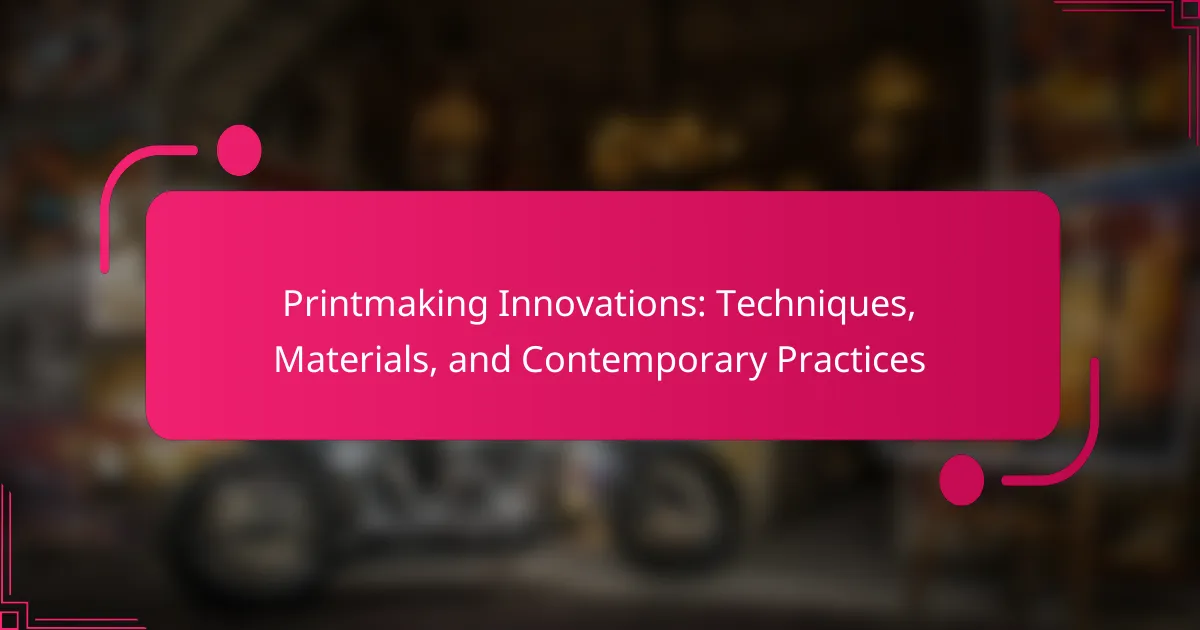Printmaking innovations are transforming the art landscape through new techniques, materials, and contemporary practices. Digital and 3D printing enhance creativity while eco-friendly inks promote sustainability. Cultural influences shape artistic expressions, blending traditional methods with modern technology. Challenges such as adapting to digital trends and sourcing sustainable materials are critical for aspiring printmakers.
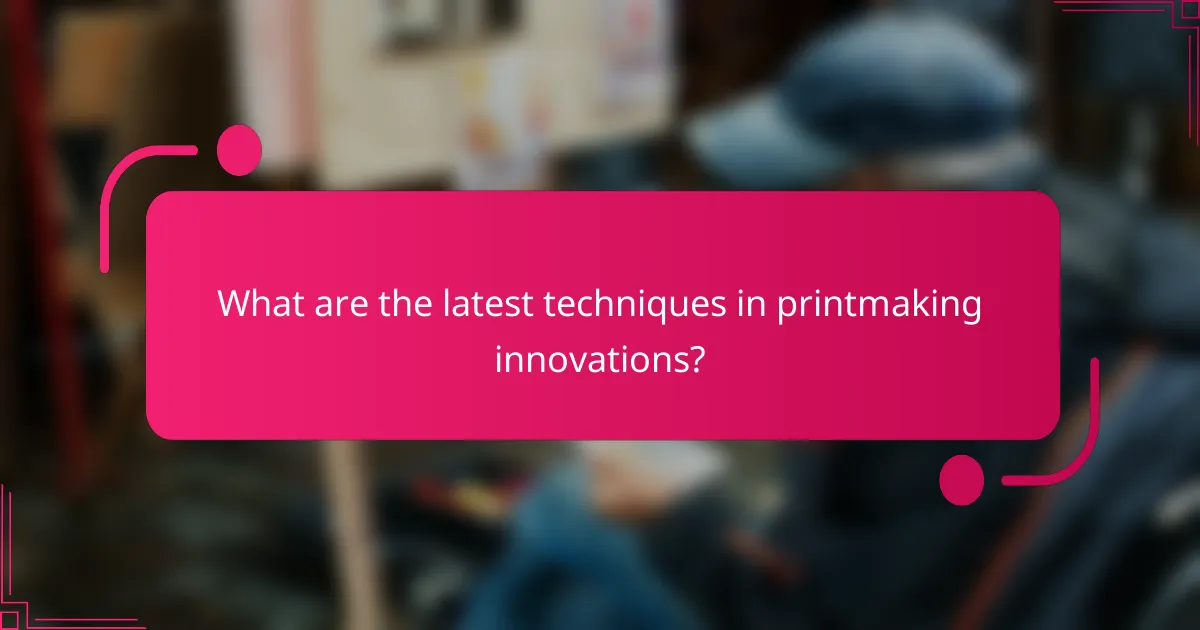
What are the latest techniques in printmaking innovations?
Printmaking innovations include techniques such as digital printing, 3D printing, and eco-friendly inks. These methods enhance creativity and sustainability in contemporary practices. Digital printing allows for intricate designs and customization, while 3D printing introduces dimensionality. Eco-friendly inks reduce environmental impact, appealing to modern artists. Additionally, advancements in laser cutting and etching provide precision and versatility, expanding the possibilities in printmaking.
How do digital technologies enhance traditional printmaking?
Digital technologies significantly enhance traditional printmaking by integrating advanced techniques and materials. They enable artists to experiment with digital tools, creating intricate designs that were previously challenging. For instance, laser cutting allows for precise patterns, while digital printing offers vibrant color options. Additionally, software applications facilitate easier manipulation of images, improving efficiency and creativity. These innovations not only expand artistic possibilities but also streamline production processes, making printmaking more accessible to contemporary artists.
What role does 3D printing play in contemporary printmaking?
3D printing significantly enhances contemporary printmaking by introducing innovative techniques and materials. It allows artists to create intricate designs that traditional methods cannot achieve. This technology enables rapid prototyping, offering flexibility in design alterations and reducing production time. Additionally, 3D printing expands the range of materials artists can use, including plastics, metals, and even bio-materials, fostering unique artistic expressions. As a result, printmakers can explore new dimensions and forms, pushing the boundaries of visual art.
Which hybrid techniques are emerging in the printmaking landscape?
Emerging hybrid techniques in printmaking combine traditional methods with modern technologies. Techniques like digital printmaking integrate digital tools with traditional processes, enhancing creativity and precision. Additionally, 3D printing is gaining traction, allowing artists to create complex textures and forms that were previously unattainable. These innovations expand the possibilities of printmaking, fostering new artistic expressions and techniques.
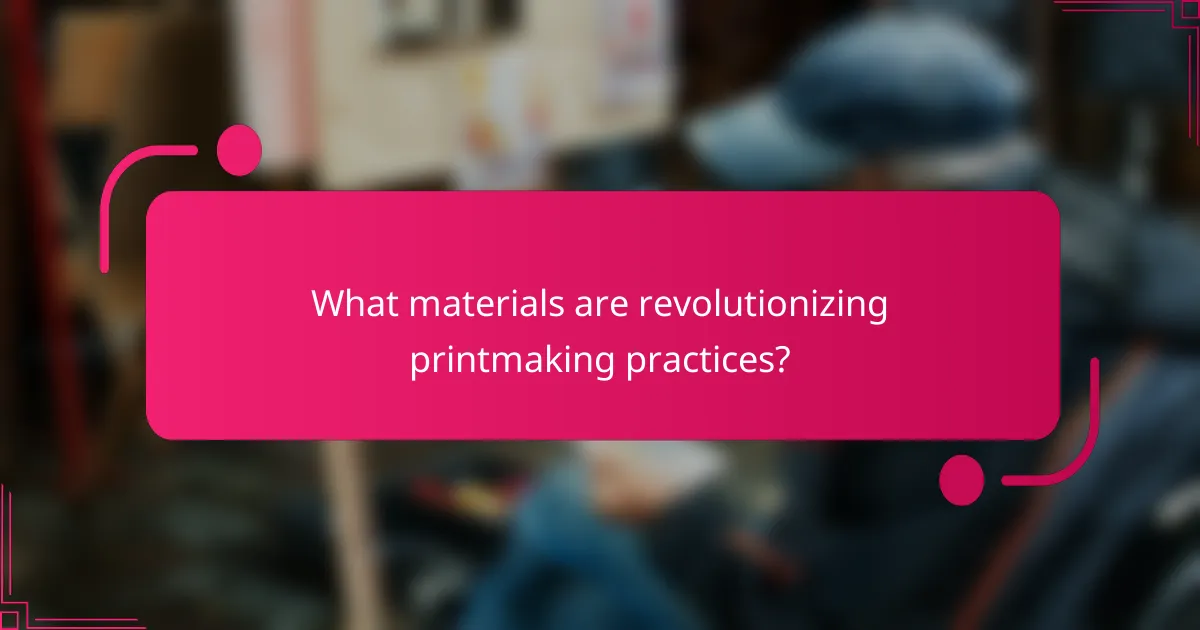
What materials are revolutionizing printmaking practices?
Innovative materials transforming printmaking include eco-friendly inks, digital substrates, and 3D printing filaments. These advancements enhance creativity and sustainability in contemporary practices. For example, water-based inks reduce environmental impact while providing vibrant colors. Additionally, flexible digital substrates allow for diverse textures and surfaces, expanding artistic possibilities. 3D printing filaments introduce a unique dimension, enabling sculptural printmaking that traditional methods cannot achieve.
How do eco-friendly materials impact printmaking?
Eco-friendly materials significantly enhance printmaking by reducing environmental impact and promoting sustainability. These materials, such as water-based inks and recycled papers, minimize harmful emissions and waste. Additionally, they often feature unique attributes, like biodegradable properties, which distinguish them from traditional options. As a result, artists can create innovative works while aligning with eco-conscious practices.
What unique inks and pigments are trending in modern printmaking?
Unique inks and pigments trending in modern printmaking include eco-friendly options, metallic inks, and UV-reactive pigments. Eco-friendly inks utilize natural materials, reducing environmental impact. Metallic inks provide vibrant, reflective qualities, enhancing visual appeal. UV-reactive pigments offer dynamic color changes under ultraviolet light, creating interactive artworks. These innovations reflect a shift towards sustainability and creativity in printmaking practices.
Which substrates are gaining popularity among printmakers?
Printmakers are increasingly using eco-friendly substrates like bamboo paper, hemp paper, and recycled materials. These options offer sustainability and unique textures. Additionally, digital substrates such as photopolymer plates are gaining traction for their versatility and precision.
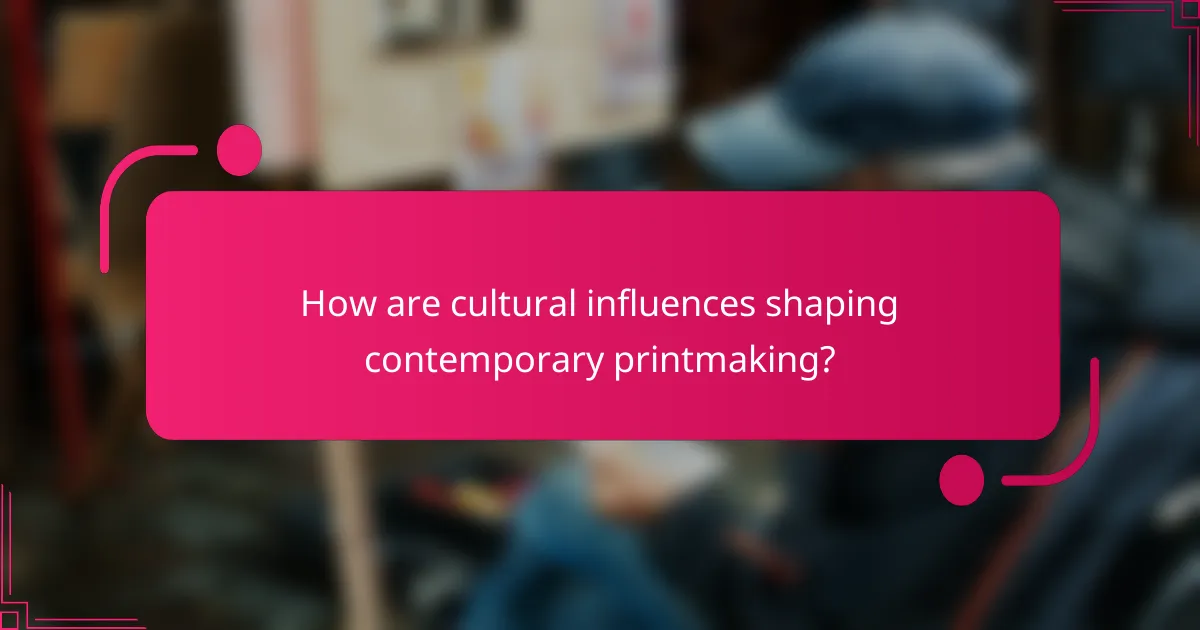
How are cultural influences shaping contemporary printmaking?
Cultural influences are significantly shaping contemporary printmaking by integrating diverse techniques and materials. Artists draw inspiration from global traditions, blending historical methods with modern technology. This fusion creates unique works that reflect cultural narratives and social commentary. As a result, printmaking evolves into a dynamic medium that engages with contemporary issues while honoring its roots.
What impact does regional art history have on printmaking styles?
Regional art history significantly influences printmaking styles by shaping techniques and materials used. Local traditions, cultural narratives, and historical contexts create distinct approaches to printmaking. For example, Japanese woodblock printing emphasizes precision and natural themes, while European styles may focus on narrative and realism. Contemporary practices often blend these regional influences, resulting in innovative expressions. This interplay showcases how regional art history enriches the printmaking landscape, fostering diversity and creativity.
How do artists incorporate social issues into their printmaking?
Artists incorporate social issues into printmaking by using innovative techniques and materials to convey powerful messages. They often address themes like inequality, environmental concerns, and human rights through their artwork. Techniques such as screen printing and relief printing allow for mass reproduction, amplifying their voices. Materials like recycled paper and eco-friendly inks reflect their commitment to sustainability. Contemporary practices include collaborations with community organizations, enhancing the social impact of their work. This approach not only raises awareness but also fosters dialogue around pressing societal issues.
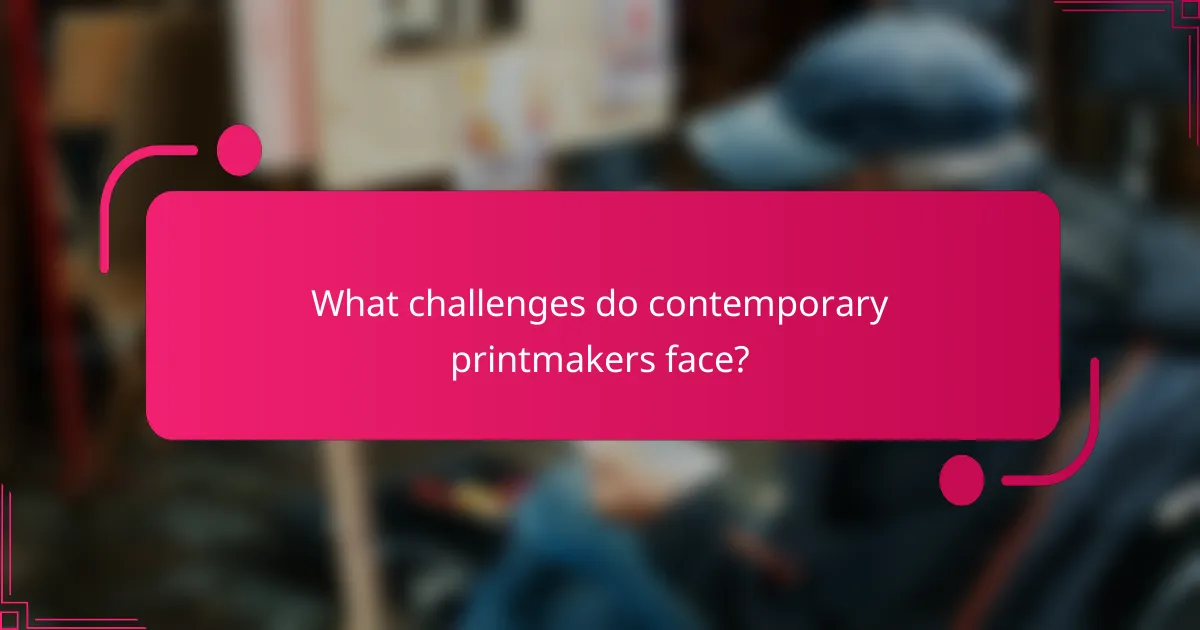
What challenges do contemporary printmakers face?
Contemporary printmakers face challenges such as adapting to digital technologies and sourcing sustainable materials. The rise of digital art has shifted market dynamics, making it essential for printmakers to innovate. Additionally, securing funding for projects can be difficult in a competitive landscape. The environmental impact of materials also necessitates a focus on sustainability, pushing artists to explore eco-friendly options. Lastly, maintaining traditional techniques while embracing modern practices presents a unique balancing act for contemporary printmakers.
How does the cost of materials affect printmaking practices?
The cost of materials significantly influences printmaking practices by dictating the choice of techniques and the overall accessibility of the art form. High material costs can limit experimentation and innovation, pushing artists towards more economical methods. For instance, traditional materials like high-quality inks and specialty papers are often expensive, which may lead artists to explore alternative materials or techniques that are more budget-friendly. This shift can result in unique styles that reflect resourcefulness and adaptability in the face of economic constraints. Additionally, the availability of affordable digital printing technologies has democratized printmaking, allowing a broader range of artists to participate in the medium.
What are the common technical difficulties in printmaking?
Common technical difficulties in printmaking include issues with ink consistency, registration errors, and equipment malfunctions. These challenges can hinder the quality and accuracy of prints. Ink consistency varies with temperature and humidity, affecting adhesion and drying times. Registration errors occur when multiple colors misalign, leading to distorted images. Equipment malfunctions, such as block or plate wear, can disrupt the printing process and require maintenance or replacement. Addressing these difficulties is essential for achieving high-quality print outcomes.
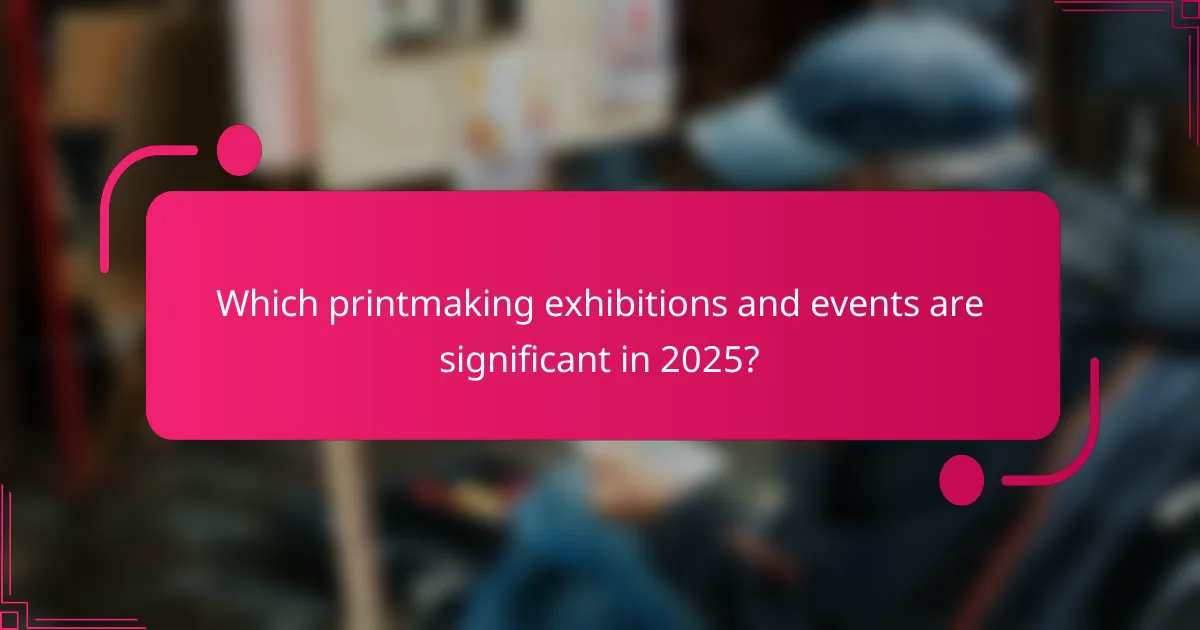
Which printmaking exhibitions and events are significant in 2025?
Significant printmaking exhibitions and events in 2025 include the Venice Biennale, the International Print Center New York, and the Tokyo International Miniature Print Exhibition. These events showcase innovative techniques, diverse materials, and contemporary practices in printmaking. The Venice Biennale will highlight global artists, while the International Print Center New York focuses on emerging trends. The Tokyo exhibition features unique miniatures, offering a rare glimpse into printmaking’s evolving landscape.
How do international print fairs promote innovation?
International print fairs drive innovation by showcasing cutting-edge techniques and materials. These events foster collaboration among artists, printers, and manufacturers, leading to new practices in printmaking. Additionally, they provide platforms for emerging artists to experiment with unconventional methods, pushing the boundaries of traditional print art. The exchange of ideas at these fairs often results in unique artworks that reflect contemporary themes and technologies.
What role do artist residencies play in advancing printmaking?
Artist residencies significantly enhance printmaking by providing artists with dedicated time, space, and resources to experiment with innovative techniques and materials. These programs foster collaboration and knowledge exchange, encouraging contemporary practices that push the boundaries of traditional printmaking. Residencies often feature workshops and mentorship, allowing artists to refine their skills and explore new concepts. Moreover, the unique environments of residencies can inspire creativity, leading to the development of rare printmaking methods that may not emerge in conventional studio settings.
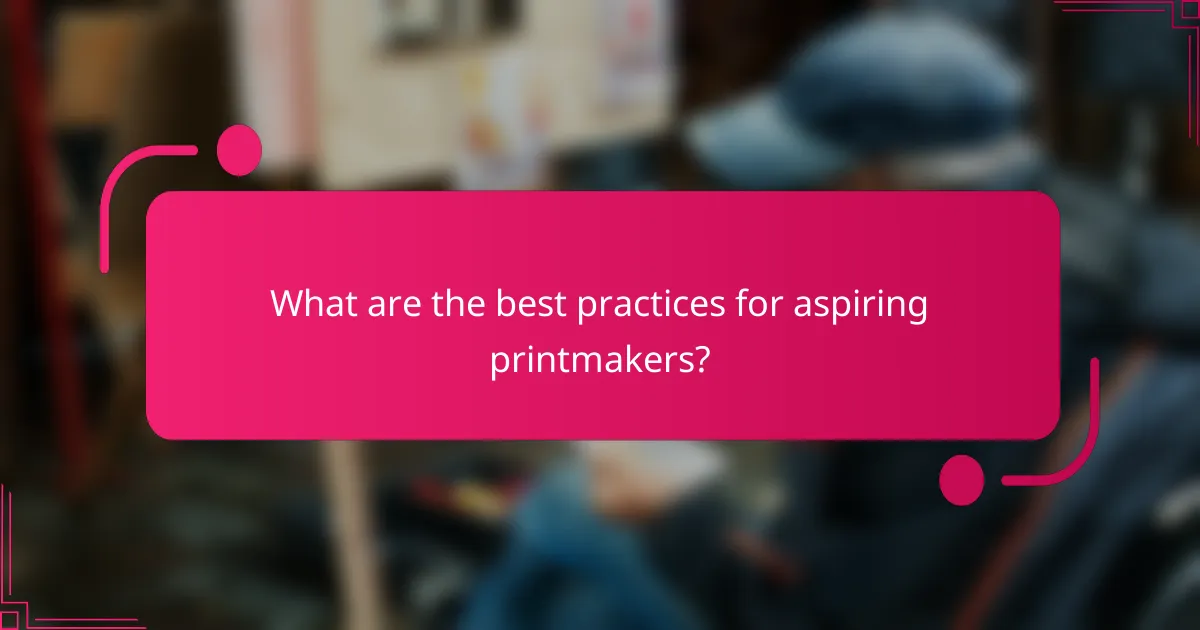
What are the best practices for aspiring printmakers?
Aspiring printmakers should focus on mastering diverse techniques, exploring innovative materials, and engaging with contemporary practices. Experimenting with digital tools alongside traditional methods enhances creativity. Networking with established artists and participating in workshops fosters skill development and community connections. Regularly curating a portfolio showcases progress and attracts opportunities. Embracing feedback from peers and mentors is crucial for growth.
How can printmakers effectively market their work?
Printmakers can effectively market their work by leveraging social media, engaging with local art communities, and showcasing their unique techniques. Focusing on storytelling around the printmaking process builds a personal connection with potential buyers. Collaborating with other artists or businesses can also expand reach. Utilizing online platforms for sales, such as Etsy or personal websites, enhances visibility. Engaging in exhibitions and art fairs allows direct interaction with audiences.
What common mistakes should new printmakers avoid?
New printmakers should avoid common mistakes such as neglecting proper preparation, using low-quality materials, and skipping experimentation. These errors can hinder creativity and technical skill development.
1. Skipping planning: Failing to plan the design and process can lead to wasted materials and time.
2. Ignoring safety: Not using protective gear or proper ventilation can pose health risks.
3. Overlooking drying times: Rushing the drying process can ruin prints and lead to frustration.
4. Insufficient cleaning: Not cleaning tools and surfaces properly can affect print quality.
5. Avoiding feedback: Not seeking critiques can limit growth and improvement in techniques.
How can collaboration enhance printmaking projects?
Collaboration enhances printmaking projects by fostering creativity, sharing diverse techniques, and expanding resource access. Working together allows artists to experiment with new materials and methods, leading to innovative outcomes. Collaborative efforts can also provide valuable feedback, improving individual skills and collective results. Additionally, partnerships may increase exposure and reach within the art community, creating opportunities for exhibitions and sales.
